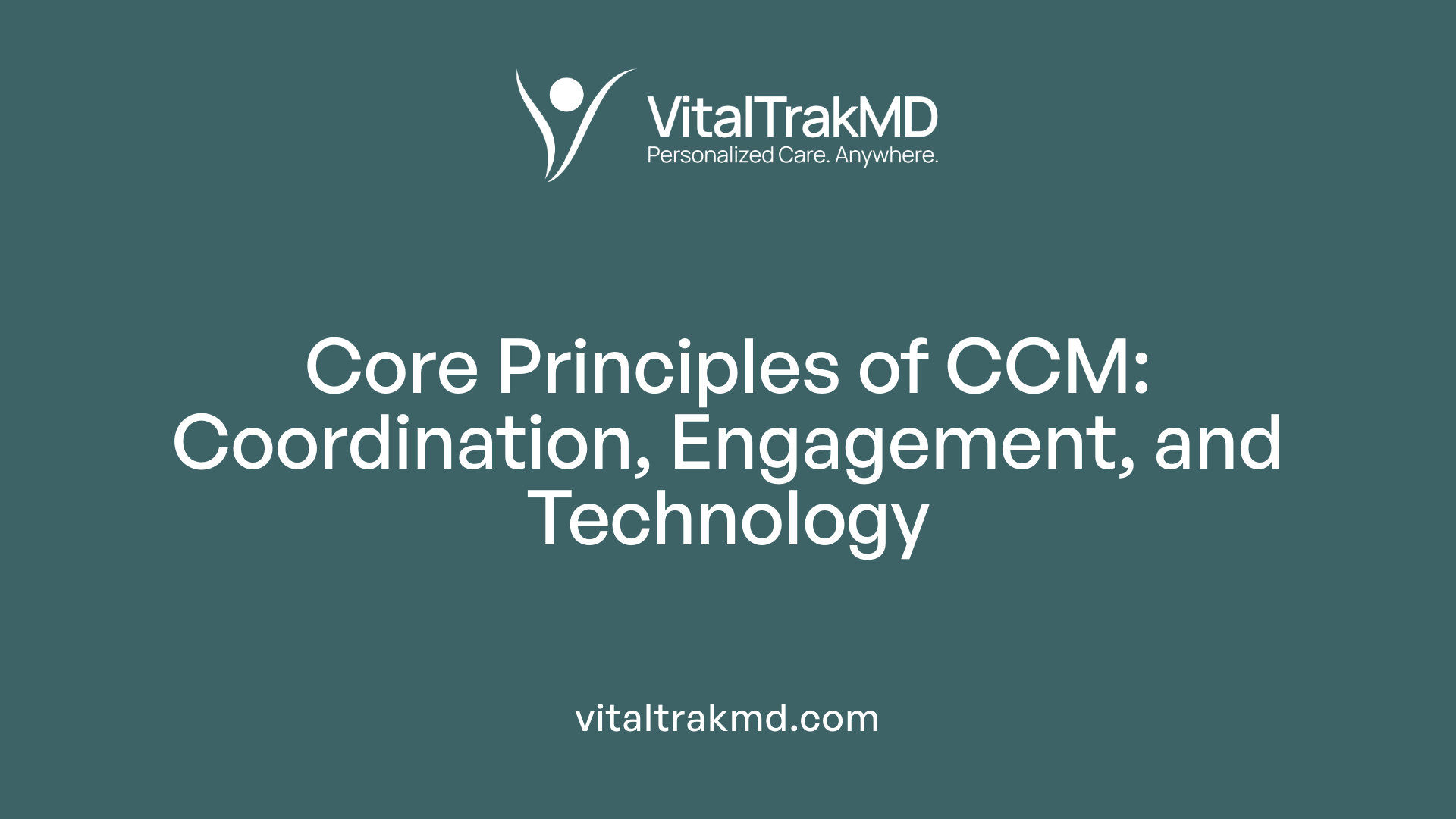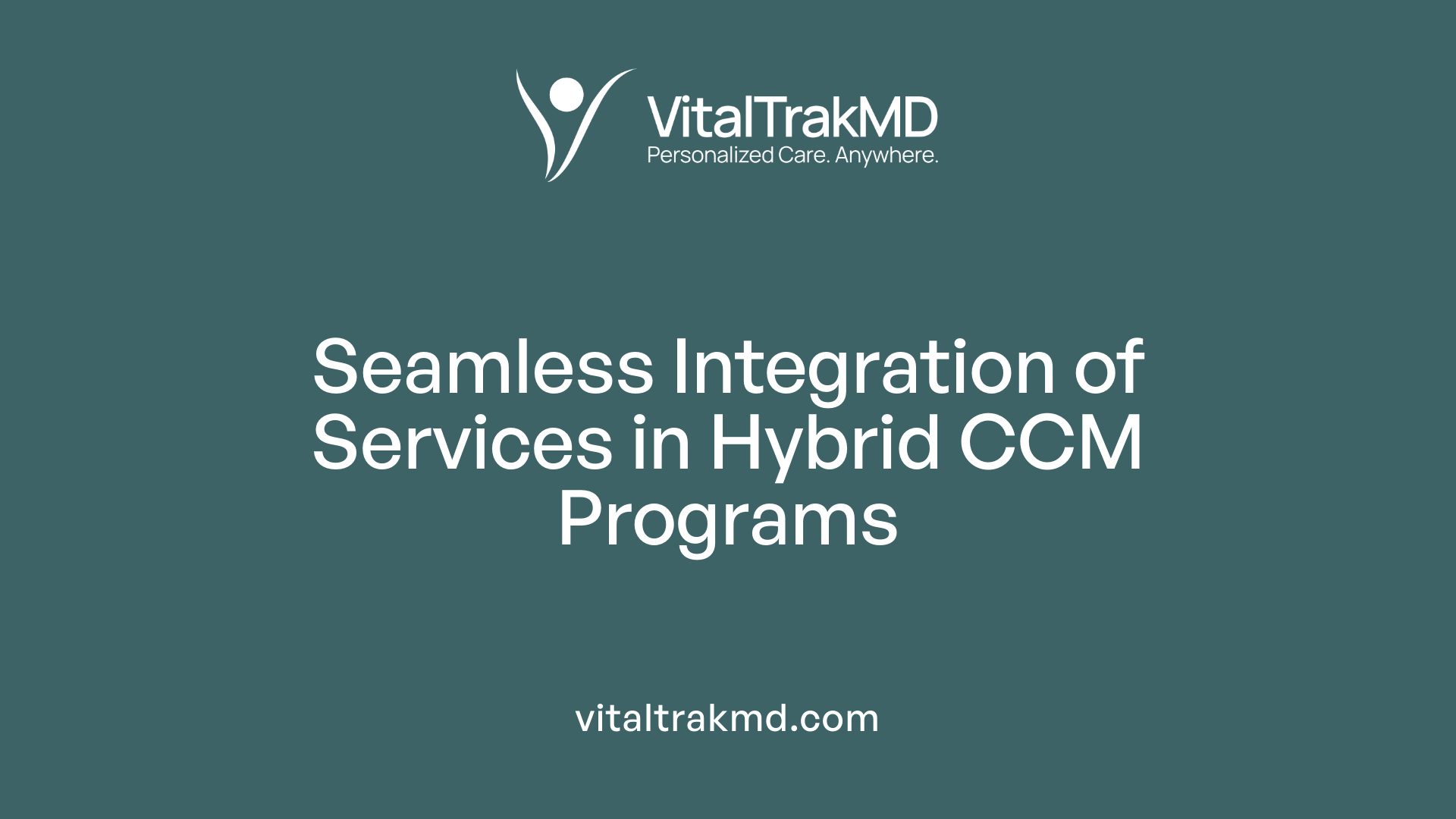Understanding Chronic Care Management Structures in Hybrid Plans

Advancing Healthcare through Hybrid CCM Frameworks
As healthcare systems evolve towards value-based models, understanding the intricate structures of Chronic Care Management (CCM) within hybrid plans becomes essential. These innovative frameworks blend traditional face-to-face services with digital health, remote monitoring, and policy-driven models to optimize long-term chronic disease care. This article explores the components, organizational models, and future trends shaping hybrid CCM, emphasizing how integrated care pathways enhance quality, efficiency, and patient outcomes.
Defining Chronic Care Management (CCM) in Modern Healthcare

What is CCM?
Chronic Care Management (CCM) is a proactive, patient-centered approach designed to coordinate and enhance care for individuals battling multiple chronic conditions such as diabetes, depression, or heart disease. It primarily involves non-face-to-face services like care coordination, medication oversight, health education, and symptom support, delivered by qualified healthcare professionals outside of traditional in-person visits. A cornerstone of CCM is the development of a tailored, comprehensive care plan that addresses the patient's unique health needs, goals, and environmental factors. This plan undergoes continuous updates based on ongoing monitoring.
By facilitating seamless communication among healthcare providers and offering around-the-clock access to urgent assistance, CCM aims to improve health outcomes, reduce hospitalizations, and enhance quality of life. Patients are required to give informed consent, understanding the services, costs, and their rights, including the option to opt out at any time. The services are billed monthly, typically based on the time spent on care coordination activities.
Core Principles of CCM
CCM operates on several fundamental principles that emphasize holistic, ongoing care. These include establishing a continuous patient-provider relationship, emphasizing care coordination, and supporting patient engagement in managing their health. Technology plays a vital role, with the use of electronic health records, remote monitoring tools, and secure communication channels ensuring timely and accurate information sharing. The model also demands structured documentation, including care plans, medication management, and care transition protocols.
Supervision of these services generally falls under 'general supervision,' meaning the healthcare provider oversees the services without physical presence during each interaction. This model encourages a team-based approach, involving nurses, physicians, and ancillary staff to deliver comprehensive support.
Key Components of CCM Services
CCM comprises several interconnected services and care components:
| Service Element | Description | Additional Details |
|---|---|---|
| Care Coordination | Streamlining information and activities among various providers | Ensures treatment plan consistency and reduces gaps |
| Care Planning | Developing and updating personalized care strategies | Covers health goals, medication management, and environmental factors |
| Patient Engagement | Involving patients in their care decisions | Includes education, motivational interviewing, and goal setting |
| Remote Monitoring | Using technology to track patient vital signs and symptoms | Enables early intervention and reduces hospital readmissions |
| Care Transition Support | Managing patient movement across different care settings | Includes follow-up calls and planning post-discharge |
| 24/7 Access | Providing continuous communication options for urgent needs | Increases patient confidence and reduces emergencies |
These elements work synergistically to provide continuous, comprehensive, and adaptable management tailored to each patient.
Conditions and Billing for CCM
CCM is suitable for patients with two or more chronic conditions expected to last at least 12 months. Common qualifying illnesses include cardiovascular disease, COPD, diabetes, depression, Alzheimer’s, and hypertension. To bill for CCM, practitioners must verify patient eligibility, obtain consent, and develop documented care plans.
Billing utilizes CPT codes like 99490 for non-complex CCM, which requires at least 20 minutes of staff time monthly. Complex CCM billing (99487) involves more extensive services. Supervision is generally at the 'general supervision' level, with documentation requirements focusing on care activities, patient communication, and coordination efforts.
The Role of Primary Care and Value-Based Systems
Primary care providers (PCPs) are central to CCM, providing overarching coordination and management. This role supports a shift toward value-based care, where financial incentives are aligned with health outcomes rather than service volume.
Models like Accountable Care Organizations (ACOs) and Patient-Centered Medical Homes (PCMHs) encourage PCPs to deliver proactive, comprehensive care using CCM and telehealth tools such as Remote Patient Monitoring (RPM). These systems promote early detection of health issues and reduce unnecessary hospitalizations, ultimately fostering a sustainable and effective long-term care environment.
Implementing CCM in Hybrid Healthcare Systems
Healthcare organizations employ various frameworks to embed CCM within hybrid care models, blending in-person and virtual services. Essential components include leadership support, robust clinical information systems, and delivery system redesign.
Implementation often involves practice transformation specialists and staff training to optimize workflows and foster team-based care. Hybrid effectiveness-implementation strategies evaluate clinical outcomes and operational success simultaneously, ensuring sustainable integration.
Care components such as remote patient monitoring, telehealth, and transitional care services are synchronized through integrated systems, ensuring seamless transitions from hospital to home and ongoing outpatient management. This integration leverages technology, interdisciplinary teams, and flexible care pathways to improve patient outcomes.
Policy, Regulations, and Future Directions
Government policies, primarily from CMS, set precise guidelines governing CCM, including eligibility, billing, and quality measures. Recent proposals focus on expanding value-based and remote care options, and new HCPCS and CPT codes facilitate simplified billing for services like virtual visits and remote monitoring.
Operational strategies involve multidisciplinary teams, advanced health IT systems, and patient engagement initiatives. Effective workflows include patient enrollment, consent, documentation, and coordination activities.
Hybrid CCM models have demonstrated positive effects, notably reducing hospital readmissions and allowing more proactive, long-term disease management. Future directions point toward integrated AI and machine learning tools, enhanced data security, and wider adoption of digital health innovations.
Emerging trends include the use of artificial intelligence to predict health risks, blockchain for secure data sharing, and multi-cloud architectures to facilitate scalable, resilient care systems. These advancements aim to refine the management of chronic illnesses, ensuring more personalized and efficient care delivery.
Implementing and Optimizing CCM within Hybrid Healthcare Systems

How are care components and services integrated in hybrid CCM programs?
In hybrid CCM programs, care components and services are seamlessly blended through a combination of care coordination, innovative technology, and team-based strategies that span various care settings. Technology plays a crucial role, with digital tools such as telehealth platforms, remote patient monitoring devices, and integrated electronic health records (EHRs) enabling real-time information sharing and coordinated care activities.
These programs often utilize consistent communication approaches among inpatient teams, outpatient providers, and virtual care staff, ensuring care pathways—whether in hospitals, homes, or virtual environments—are continuous and personalized. Integration of services like Transitional Care Management (TCM) with CCM is supported by cloud-based systems, fostering collaboration across disciplines to improve patient outcomes. The overarching goal is to craft flexible, patient-centered routes for chronic disease management, harnessing technology and multidisciplinary teamwork to deliver holistic and uninterrupted care.
What are effective operational strategies for hybrid CCM?
Operational success in hybrid CCM hinges on establishing multidisciplinary teams, investing in robust health IT infrastructure, and fostering active patient involvement. Typically, teams include nurses, social workers, pharmacists, and physicians who collaborate through shared electronic health records, ensuring consistent and comprehensive care.
Remote patient monitoring (RPM) and telehealth platforms are critical tools, enabling providers to remotely observe health indicators, respond swiftly to changes, and maintain ongoing engagement. Workflow processes should emphasize proper patient notification, obtaining informed consent, and patient education regarding services, costs, and options for opting out.
Furthermore, reorganizing reimbursement incentives around value-based metrics and leveraging data analytics for risk stratification enhance efficiency. Regular staff training and process audits help refine workflows, making the delivery of holistic, flexible, and adaptive care possible in hybrid settings.
How do hybrid CCM models influence long-term chronic disease management?
Hybrid CCM models significantly reshape long-term management of chronic illnesses by facilitating continuous, proactive care beyond conventional office visits. They enable early detection of complications through remote monitoring, which supports timely interventions and helps prevent disease progression.
These models encourage sustained patient engagement and seamless communication among healthcare teams, fostering adherence to treatment plans and optimal medication management. They also support lifestyle modifications tailored to individual needs, contributing to improved quality of life.
Economically, hybrid CCM reduces unnecessary hospitalizations and emergency department visits, leading to cost savings. Patients experience better access to personalized care, leading to higher satisfaction levels and fewer setbacks, establishing hybrid CCM as a cornerstone for effective, lifelong disease management.
What future innovations are anticipated to shape hybrid CCM frameworks?
Looking forward, hybrid CCM frameworks are expected to evolve through technological and organizational innovations. Advances in artificial intelligence (AI) are poised to improve predictive analytics, enabling preemptive care adjustments based on patient data.
Blockchain technology is anticipated to enhance data security and interoperability, facilitating smoother exchanges of health information. The proliferation of Internet of Things (IoT) devices will expand capabilities for remote monitoring, providing richer datasets for clinical decision-making.
Multi-cloud and microservices architectures will allow scalable, flexible data ecosystems, making systems more resilient. Automation powered by AI will streamline administrative routines and clinical workflows.
Policy shifts promoting expanded telehealth services and value-based contracts will further support flexible, patient-centered care models. These innovations aim to enhance efficiency, improve health outcomes, and create adaptive, data-driven approaches for chronic condition management across diverse healthcare environments.
How are digital tools employed to facilitate hybrid CCM implementation?
Digital tools are fundamental to hybrid CCM, offering platforms for telehealth consultations, remote patient monitoring, and comprehensive EHR integrations. Telehealth enables real-time audio and video consultations, ensuring continuous connectivity between providers and patients.
Remote monitoring devices gather vital signs, symptom reports, and medication adherence data, transmitting insights directly to care teams for quick action.
Cloud-based EHR systems enable care coordination across various care sites, allowing providers to access up-to-date patient information regardless of location. Embedded decision support tools enhance clinical judgment, ensuring appropriate interventions.
Together, these digital technologies empower healthcare providers with timely, accurate data and communication channels, ensuring holistic, patient-centered, and efficient care delivery within hybrid systems.
What are the policy considerations for billing and compliance in hybrid CCM models?
Billing and compliance in hybrid CCM models require careful adherence to Medicare and federal regulations. Accurate documentation of non-face-to-face care activities, including the time spent on care coordination and patient communication, is essential for proper billing.
Patient consent must be obtained to explain service scope, costs, and billing rights, with clear disclosure about services like remote monitoring and telehealth.
Compliance also involves ensuring that services meet medical necessity standards and that billing codes are correctly applied based on activity type and duration. Particularly, integration with remote monitoring and telehealth must comply with federal privacy, security, and licensure standards.
To prevent duplicative billing and maximize reimbursement, healthcare providers need to establish clear service hierarchies and documentation practices. These policies ensure high-quality, accountable care while safeguarding against fraud and billing errors.
In what ways does operational flexibility enhance CCM program effectiveness?
Operational flexibility allows healthcare organizations to quickly adapt workflows, incorporate emerging technologies, and modify service offerings in response to changing patient needs, policy updates, or technological advancements.
Flexible operations facilitate the integration of telehealth, remote monitoring, and interdisciplinary team collaborations, ensuring comprehensive care delivery.
They also permit customization of care pathways tailored to patient risk levels and preferences, supporting higher engagement and better outcomes.
Moreover, operational agility encourages continuous process improvement, staff training, and innovation, which collectively strengthen the robustness and scalability of CCM programs. This adaptability is vital for maintaining effective, patient-centered care in dynamic healthcare environments.
How does the integration of social determinants of health influence hybrid CCM outcomes?
Incorporating social determinants of health (SDOH)—such as housing stability, transportation access, economic status, and social support—enhances hybrid CCM's capacity to provide holistic, personalized care. By assessing and addressing external factors impacting health, providers can tailor interventions to overcome social barriers that hinder adherence or exacerbate health disparities.
Effective linkages to community resources, social services, and environmental support systems help mitigate social risks, leading to increased patient engagement, reduced hospital readmissions, and improved health outcomes.
Embedding SDOH considerations within care plans fosters a comprehensive approach that recognizes external influences on health, resulting in higher patient satisfaction and equity in healthcare delivery.
Conclusion: The Future of Hybrid CCM and Long-Term Care

What are the effects of hybrid CCM structures on healthcare delivery and long-term chronic condition management?
Hybrid Chronic Care Management (CCM) models are revolutionizing how healthcare providers support patients with chronic illnesses. By combining in-person visits with remote monitoring and virtual communication, these structures foster a continuous, patient-centered approach. This integration enhances care coordination, ensuring that all providers are aligned in their treatment plans. Patients benefit from improved engagement, adherence to medication, and proactive management, which collectively lead to better health outcomes.
Significantly, hybrid CCM reduces hospitalizations and emergency visits by enabling early detection of health issues through remote monitoring devices. This early intervention curbs disease progression and promotes quality of life. Financially, healthcare providers experience increased revenue streams through reimbursements for non-face-to-face services. This model also contributes to system sustainability by decreasing reliance on costly acute and inpatient care.
In essence, hybrid CCM structures transform episodic care into an ongoing, sustainable system capable of managing complex, long-term conditions effectively, aligning with modern value-based healthcare priorities.
Embracing the Future of Chronic Care Management
The landscape of chronic care management within hybrid healthcare plans is rapidly evolving, driven by technological advancements, policy reforms, and a shift towards value-based care. Integrating traditional in-person services with digital health tools—such as telehealth, remote monitoring, and comprehensive care management programs—offers a holistic approach to managing long-term conditions. These hybrid models improve care coordination, patient engagement, and health outcomes while reducing unnecessary costs. Looking forward, continued innovation in AI, blockchain, and scalable cloud systems will further enhance care delivery, making it more personalized, efficient, and resilient. As healthcare systems adapt and expand these hybrid frameworks, they will play a crucial role in shaping the future of sustainable, patient-centered, and outcome-driven chronic care.
References
- [PDF] MLN909188 – Chronic Care Management Services - CMS
- Understanding the New Advanced Primary Care Management ...
- The Complete Guide to Chronic Care Management
- Chronic Disease Self-Management: A Hybrid Concept Analysis - PMC
- Transitional Care Management Hybrid Approach to Chronic Care ...
- Advanced Primary Care Management (APCM) Program: What to Know
- Chronic Care Management: Beneficiaries and Importance - DocsInk
- Value-based Care Solutions: Hybrid Payment Models for Primary Care
- Value-Based Care Management for Patient Centeredness
- Chronic Care Management: The Ultimate Guide - Signallamp Health
Recent articles
Want to Feel Better and Live Healthier?
Join hundreds of patients taking control of their health with personalized care that fits their life – not the other way around.
Rated 4.8/5 by 32+ customers







